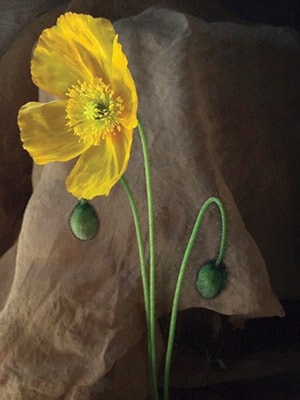Let’s talk poppies. They have just come into bloom and are both exasperatingly abundant and tricky to grow from seed. But before I get to the cultivation requirements, let’s start with a primer on some common varieties.
The most famous poppy is the Flanders field poppy, Papaver rhoeas, which is a bright scarlet, single-petalled species suited to growing in disturbed soil, hence its appearance after the First World War. Also called corn poppy, this is a European agricultural weed, but still stunning singly or en masse. Like all poppies, the bloom period of the plant is short but arresting in its intensity – hence the decision at the Tower of London to do a sensational display of ‘blood red’ ceramic rhoeas flowing forth from the castle, symbolizing all the lives lost by Britain in the Great War.
The seed of many poppies can lie dormant until the conditions are right for growth: temperatures of about 16 Celsius, ample sun and lean soil. (Seed dormancy is a strategy many weeds use to survive. I recently learned that mullein seed is viable for 100 years, so if you are still yanking out a plant you swore you eradicated ages ago, accept that many may outlive you).
The opium poppy Papaver somniferum is now naturalized in many parts of the world, including my garden where it is a welcome early summer filler, offering glaucous lettuce-like leaves and delicate mauve pompon flowers, followed by architectural seed heads in July. This is the same poppy which gives us poppy seeds for baking and interestingly also codeine, morphine and opium.
The drugs are produced from the poppy sap (the famous ‘poppy tears’), but the seeds contain few active compounds. Still, opium poppy was banned from production in the US and Canada, and I believe it still may be illegal to grow it (for drug production, not seed). If you’re looking for a good ‘breadseed’ poppy variety (there are lovely reds and purples marked with maroon available), try a heritage seed company from the prairies; Eastern European immigrants thankfully held on to old varieties.
The California poppy, Eschscholzia californica, the shocking orange poppy of rock outcroppings and highway verges is drought tolerant.
Welsh poppies (which are perennial) are clear yellow and darling, popping up in shady damp corners in May and June. They are actually not a Papaver, but a Meconopsis – of blue poppy fame – and the species cambrica. I encourage them by shaking the seed heads when they form: really that’s all one needs to do, and if you find you have too many, are easily yanked up.
Another perennial poppy that has adapted to drought is the Oriental, the large hairy garden variety available in a wide range of colours from white through burgundy. Many lose their leaves in the summer after flowering, but the leaves re-emerge in the fall.
Now to my favourite: the Icelandics, Papaver nudicale. This poppy has thin hairy stems and delicate downward facing buds which open to a wide array of tissue paper flowers, depending on the variety. I’m currently growing the ‘Champagne Bubbles’ series, and a mixed nudicale series from West Coast Seeds.
The Bubbles and Sherbet series grow on stems over a foot long, have lovely limey foliage and blooms measuring up to six inches in diameter with lush yellow stamens. I cannot wait for these to bloom because my germination rate was low from a March sowing. This year I plan to sow them in the fall and overwinter them for earlier bloom. The seed is minuscule and poppies abhor transplanting, but patience and faith seem to have earned me a small crop. When their buds crack – any day now – I shall sear their stems with blowtorch (or a match), to allow me to appreciate them as they open in the vase.
Christin Geall is an avid Oak Bay gardener and creative non-fiction writing instructor at the University of Victoria.
